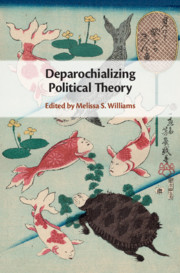Book contents
- Deparochializing Political Theory
- Deparochializing Political Theory
- Copyright page
- Dedication
- Contents
- Tables
- Contributors
- Preface and Acknowledgments
- Note on the Text
- 1 Introduction
- 2 Deparochializing Political Theory and Beyond
- 3 Recentering Political Theory, Revisited
- 4 A Decentralized Republic of Virtue
- 5 Deparochializing Political Theory from the Far Eastern Province
- 6 Is Popular Sovereignty a Useful Myth?
- 7 Authoritarian and Democratic Pathways to Meritocracy in China
- 8 Deparochializing Democratic Theory
- 9 Teaching Comparative Political Thought
- 10 Teaching Philosophy and Political Thought in Southeast Asia
- 11 Why Globalize the Curriculum?
- Index
10 - Teaching Philosophy and Political Thought in Southeast Asia
Published online by Cambridge University Press: 15 March 2020
- Deparochializing Political Theory
- Deparochializing Political Theory
- Copyright page
- Dedication
- Contents
- Tables
- Contributors
- Preface and Acknowledgments
- Note on the Text
- 1 Introduction
- 2 Deparochializing Political Theory and Beyond
- 3 Recentering Political Theory, Revisited
- 4 A Decentralized Republic of Virtue
- 5 Deparochializing Political Theory from the Far Eastern Province
- 6 Is Popular Sovereignty a Useful Myth?
- 7 Authoritarian and Democratic Pathways to Meritocracy in China
- 8 Deparochializing Democratic Theory
- 9 Teaching Comparative Political Thought
- 10 Teaching Philosophy and Political Thought in Southeast Asia
- 11 Why Globalize the Curriculum?
- Index
Summary
Terry Nardin’s chapter grows out of an experiment in cross-cultural teaching that has flourished at the Yale-NUS College in Singapore. The program crosses the civilizational boundaries that often define the way political theory is taught and refuses the usual distinction between “Western” and “non-Western” thought. This distinction privileges European thought, throwing the rest of the world into a residual category, obscuring the fact that the rise of “the West” brought much of the world under the dominating rule of Europeans. Drawing on ancient and modern texts from India, China, and the Islamic world as well as from Europe, the course combines the close reading of both political and philosophical texts. By drawing on a wider range of texts than is usual in political theory courses, it invites students and teachers to explore a diversity of genres and their associated contexts, presuppositions, and reverberations. It addresses disputes about canons, relevance, translations, and expertise, inviting students to engage with a broad intellectual inheritance. It illustrates how faculty can educate one another as they teach all the students in a liberal arts college how to transcend parochialism by sharpening their capacities for philosophical and political reasoning.
Keywords
- Type
- Chapter
- Information
- Deparochializing Political Theory , pp. 254 - 272Publisher: Cambridge University PressPrint publication year: 2020

